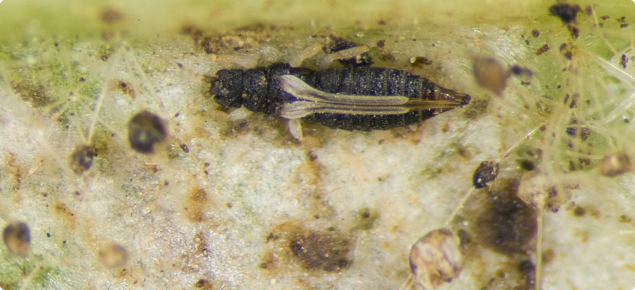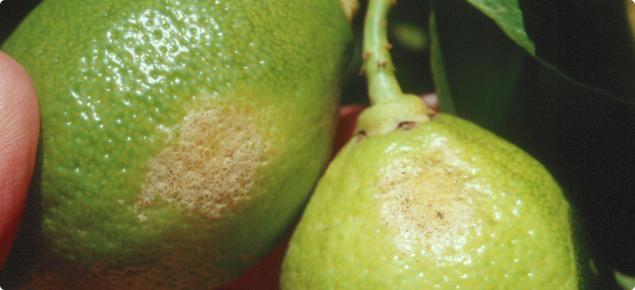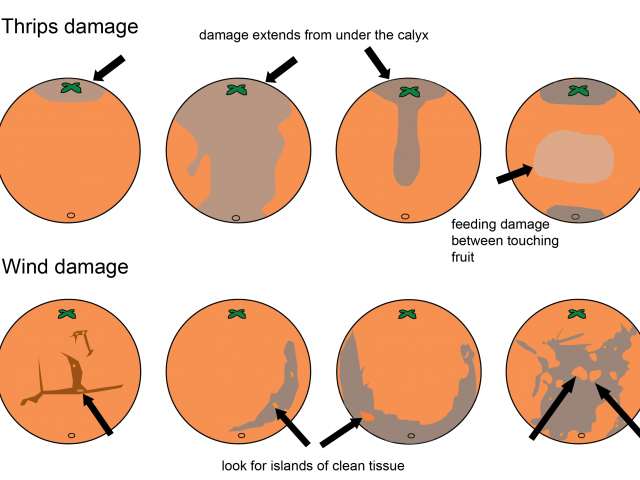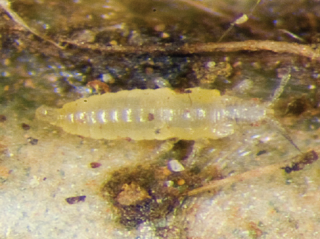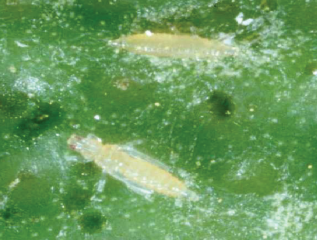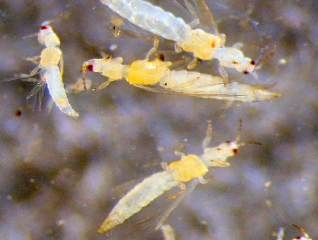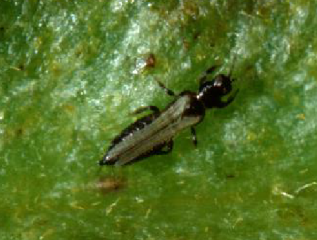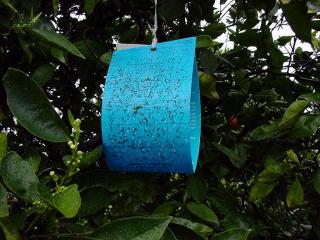Damage
- Thrips can damage developing and mature fruit.
- Feeding damage to fruit is recognisable as a ring of damaged tissue or ‘halo’ at the stem end (Kelly’s citrus thrips), or as russet or grey scarring or bleaching between touching fruit. Bleached patches on mature oranges and grapefruit are most likely to be caused by greenhouse thrips.
- Damage tends to occur in sheltered areas, as thrips like to feed in protected areas.
- Fruit scarring downgrades fruit quality, reducing the packout of local and export quality fruit.
Thrips or wind damage?
- To prevent unnecessary spraying, determine whether the cause is thrips as wind damage can be confused with thrips damage.
- Wind tends to cause single or multiple transverse or diagonal scars across the face. Fruit are most susceptible to early wind marking when they are about 8mm in diameter, that is for about 12 weeks after petal fall.
- Older leaves being blown to and fro across the surface of the young fruit often cause early wind marking. This damage results in the formation of a protective layer of underlying cells.
- Once fruit is about 3cm in size, the skin has hardened and is unlikely to be damaged by leaves. Damage at this stage is more likely to be caused through scratching of the fruit by dry twigs.
- Late wind markings are usually diagonal or transverse. Scars tend to be sunken and may be silver to black.
Minimising wind damage
- Planting wind breaks or the use of artificial windbreaks is recommended to minimise wind damage.
- Pruning out dead wood after picking the fruit can further reduce wind damage.
Other damage
- Fruit can also be damaged by other species of insects, mites, moths, snails, fungi and bacteria. Mealybugs and scale can infest fruit and also promote the formation of sooty mould.
- Physiological disorders such as rind creasing, corrugations etc. can affect fruit appearance.
- Physical blemishes to fruit can also occur through damage by hail, spray burn, water burn and external blemishes through picking and packing.
Thrips life cycle
- All species have a similar life cycle with five stages – egg, larva, prepupa, pupa and adult.
- Of these, you are most likely to find larvae and adults.
- Adults have fringed wings that are often folded back over the body.
- Larvae (first and second) do not have wings.
- The prepupa and pupa are often present in the leaf litter or soil.
Identification
- As thrips are tiny, identification using a hand lens may be difficult.
- Kelly’s citrus thrips and greenhouse thrips have black adults. Tomato thrips are also black, but differences allow you to separate them.
- If in doubt of your identification, or if you think you have found a different species of thrips to that depicted here, have the specimens identified. Contact your local DAFWA office for further details.
Species known to cause damage
Greenhouse thrips
- Introduced species.
- Adults are black, 1.5mm long, with yellow legs. The wings are white to translucent and folded back over the body.
- Larvae are white or pale yellow with red eyes. They produce a globule of faecal fluid at the tip of their abdomen.
Damage: bleaching or scarring between touching fruit, sprinkled with black spots (excrement). Leaves may also be attacked giving them a dirty, spotted appearance.
Kelly’s citrus thrips
- Introduced species.
- Adults black, 2-3mm long, with black legs. The wings are dark with a small clear band at the top.
- Nymphs pale yellow.
Chilli thrips
Chilli thrips (Scirtothrips dorsalis) are found throughout the world and were first reported in north Western Australia about 20 years ago.
Like most thrips, chilli thrips are sap-sucking insects that can cause deformities in flowers, leaves, stems, and shoots. Also known as strawberry thrips and tea thrips, chilli thrips feed on all citrus and their hybrids, as well as a range of fruit and vegetable hosts, and roses.
Thrips are most active during spring, summer and autumn. Recent rainfall and humidity has created conditions that are conducive to chilli thrips, which feed on the sugars in new shoots.
More information on chilli thrips on roses in the Perth metropolitan area is available on the website here.
Orchard species not known to cause damage
Plague thrips (Thrips imaginis)
- Native to Australia.
- The female is light brown or grey, 1.2mm long, with light brown legs. Males are smaller and yellow.
- The wings are yellow to light brown and are folded back over the body.
- The nymphs are white or yellow.
Onion thrips (Thrips tabaci)
- Introduced.
- Adults are pale yellow to light brown, 1.2mm long.
- Males are smaller.
- Larvae are white or yellow, 0.5-1.2mm.
Tomato thrips (Frankliniella schultzei)
- Introduced.
- Adults vary from yellow to dark brown or black, 1mm long, with black legs.
- Larvae are white or yellow.
Monitoring
What do I sample?
- Sample the fruit using a hand lens. Look under the calyx for thrips.
- The use of sticky traps for monitoring is not recommended. This is because thrips collected from sticky traps easily lose hairs and other body parts that are essential for identification.
How many fruit do I sample?
- Depends on the size of the block and the amount of time that available for sampling.
- As a guide, sample at least 50 fruit for thrips (total 10 trees). Use a hand-held counter so you don’t lose count of how many fruit you have looked at.
- If you have had problems with Greenhouse thrips before, you may want to sample where they were previously a problem. Greenhouse thrips tend to occur within the most moderate microclimatic areas of the orchard, which are consistent from year to year.
How often should I monitor?
How many thrips can I find before I need to take action?
Management
Chemical control
- Petroleum spray oils can be used to control thrips and are compatible with IPM programs. Thorough coverage is very important.
- Spray for greenhouse thrips before young fruit come into contact with each other.
- Early harvest will also help reduce damage from greenhouse thrips, since they will also damage ripe fruit.
Biological control
- Predatory thrips such as the native Haplothrips spp. attack Kelly's citrus thrips.
- The parasitic wasps Thripobious semiluteus, Megaphragma mymaripenne and Ceranisus sp. parasitise greenhouse thrips. Thripobious semiluteus has established in WA and appears to be most active and abundant in autumn.
- Predatory mites, bugs and spiders will also attack thrips.
Further reading
Citrus pests and their natural enemies: integrated pest management in Australia edited by D Smith, GA Beattie & RH Broadley, published by Queensland Department of Primary Industries, 1997.
Thrips, wind and other blemishes by ECG Bedford. In: Citrus Pests in the Republic of South Africa 2nd ed. Edited by ECG Bedford, MA van den Berg, & EA de Villiers, published by the Institute for Tropical & Subtropical Crops, Nelspruit, RSA, 1998.
Kelly citrus thrips management by G Baker. South Australian Research and Development Institute (SARDI), September 2006.

